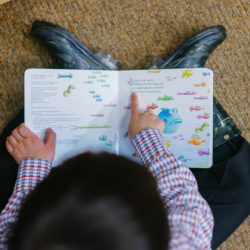Google “school preparedness” and you’ll find a lot of helpful articles. But as a parent and teacher, I have realized the importance of the readiness of both child and parent.
Start Early
Whatever age your child may be, any transition after a long break—having a new school, teachers, and routine—can be daunting for your child and you, too! Advanced preparation always works. Please, no more cramming! As early as a month before opening day, slowly ease into a routine. A schedule gives your child a sense of security, giving his system time to gear up for upcoming activities.
Start with Self
As a parent, you powerfully influence your child’s attitude about everything. If you want her to have a good balance of independence and friendliness, and a sense of calm and diligence, model that to her. Before you can soothe her anxieties and excite her for the new adventure, have a good grip on yourself—your health and well-being. If you are sickly, stressed, and harried, your child will easily sense that things are going to be difficult. Take time to care for yourself and learn to handle your emotions.
Welcome changes! Rather than fussing about sleep deprivation and focusing on the financial challenges, know that such upcoming variations to your day and lifestyle only mean growth for both you and your child.
Sure, there’ll be tears of both sadness and joy when the big day comes. Being transparent about your feelings will encourage your child to express herself and accept that emotions are valid. But try to “manage your breakdowns.” Hold off on your “My baby!” howls until after seeing your child off to his school gate or ride. Nurture your spirit with God’s Word, and learn from people who strengthen your faith and are cheerful and affirming.
Strike a Balance
Balance is key to prep our families for school opening: aim to neither be too lax nor too controlling. When we’re overly chill about school supplies the night before Day 1, the child may feel worried that he won’t have what is needed on that day. On the other hand, when we’re obsessing and checking his bag over and over again, he will pick up the same habit of stressing too much for Opening Day.
Speak Up, Speak Out
What encouraging words can we say to our kids to help prepare them emotionally, mentally, and spiritually for school opening? Ask yourself, “What would I want to hear to comfort my uneasiness about school?” Start with, “Let’s get ready as early as we can” and “We will be okay.”
Take time to find out what’s going on inside them—what they think and how they feel about school opening. Help them express their delight, worries, or fears by assuring them that you’d like to listen and exchange stories. Your kwentuhan (storytelling) should include direct yet casually-asked questions to pinpoint areas of concern.
A child who isn’t expressive can be gently nudged to speak out when given fun multiple choices. For instance, “How do you feel about being Grade 1 in a new school? Do you feel like:
- a jumping jelly bean (nervous);
- melting ice cream (overwhelmed/scared);
- a lonely teddy bear (shy); or
- a bucket of sunshine (excited!)?”
Young children and teens relax more when the Q&A is playful, and done over a snack, or a stroll together.
Sort it Out
Try to address all issues. Assure your child that you’ll do your best to assist her—whether it’s just to hear her out, pray, find tangible ways to alleviate fears, or solicit help from a more qualified adult.
There are times a child has unexpressed anxieties. In some of these situations, he may not need his parents to fix it, but just to understand and “get it” through empathy. (Know What To Say, What Not To Say here)
Often, the concerns of a student are about:
Getting to school on time
Dina Ocampo, Ph.D., professor and former dean of the UP College of Education, also former undersecretary of the Department of Education, advises parents to help establish a sleeping pattern a week or two before school, to help adjust the body to a school day schedule. Encourage her to sleep early weeks before the first day. Gently wake her up or set the alarm 30 minutes to an hour before the time she must leave the house. Give enough time for commute, allowing an extra 15-30 mins for traffic and other possible but unpredictable hindrances to punctuality: a ripped/stained uniform, flat tire, road repair, spilled snacks, forgotten ID!
Knowing where to go
Dr. Ocampo mentions that some schools have: “a phase-in program: five kids come in on Monday, five on Tuesday, and then later on, on Friday, sama-sama silang lahat (they meet as the actual big group).” On those days, they are given a tour and a new routine is introduced. If your school does not have this in place, request the teacher for a walk-through before classes start. Your dry run can even begin at home, from waking up to your bathroom routine, breakfast, and commuting whether in a private or public vehicle.
Your child will get less jittery about navigating his way by identifying with him important places: his classroom, restrooms, cafeteria, public phone and clinic. Aside from a tour, you can ease his anxiety by getting or sketching a map he can keep in his bag.

Knowing how it’s going to be like
Nina Jacob-Soliven, a language development specialist and a teacher of the hearing-impaired, recommends that the parent acquaint the child with what to expect during school hours. For example: “When you enter the school gate, you must put your lunch box on the table to your right, put your bag inside your room, go play in the playground until Teacher Ella calls you, line up, walk quietly to your room…” You can even walk your fingers through your map, or simulate the day in your house with pretend-places.
Knowing a friend and who to go to
Friendships are important for all the children. Reach out to other parents, and go for a playdate such as some bonding time over ice cream, even before opening day.
Connect with your child’s adviser, school nurse, and security guard. Introduce them to your child as people they can go to when they need help.
For a child with special needs, both Ocampo and Jacob-Soliven strongly suggest that the parent assure him that help is available, such as a shadow teacher. Dad and Mom must coordinate with the school’s guidance or learner support team to connect with other families before school starts.
Being prepared with all his supplies
Dr. Ocampo also reminds parents to “involve the child in the process” of purchasing supplies, like a new school bag, and snacks. Their participation in completing the checklist, choosing what to buy, packing up and the newness of his things can excite him about the start of the school year.
Shush or Shine
Encourage your child to be friendly and get to know new people; to be polite, and wait for their turn. Dr. Ocampo endorses practicing them with lines to say in asking for a classmate’s name, greeting teachers, and even in encountering conflicts. It might be too early to expose them to the reality of bullies but you can already set guidelines to be cooperative instead of competitive with others. “Do not fight with others. If someone is hurting you, tell Teacher,” are a few rules you can begin with.
Cheer them on with “Win a friend” instead of “Win over them.” Motivate them with “Give your best” over “Show them who’s the best.” When you see your child after school, share with him how you met a new parent and became friends. Ask your child: “How was your day?” instead of “Is there homework?” Find out: “Did you get to meet someone new?” rather than “How did you do in the test?”
As early as school age, we need to help our kids realize that satisfaction in life is not about achievement or popularity but being the best you can be in the eyes of God, which includes being a good friend. The best time to start—or restart—is School Day 1.

More into numbers than words, Richelle Joson-Ligot grew up writing merely in her head and in her heart, making up stories and characters, mixing up syllables to mean a new idea, and recording these all on diaries and in cassette. A voice talent, homeschooler, creative consultant, and choreographer, she is gifted in many ways, but considers the best gifts in her life to be the people the Giver has blessed her with – husband Tot, and children Mishka, Nikita, Miro and Yakob.




